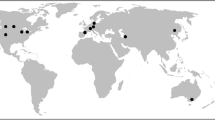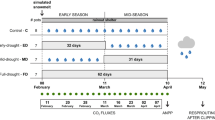Abstract
Extreme drought events challenge ecosystem functioning. Ecological response to drought is studied worldwide in a growing number of field experiments by rain-out shelters. Yet, few meta-analyses face severe challenges in the comparability of studies. This is partly because build-up of drought stress in rain-out shelters is modified by ambient weather conditions. Rain-out shelters can further create confounding effects (radiation, temperature), which may influence plant responses. Yet, a quantification of ecophysiological effects within rain-out shelters under opposing ambient weather conditions and of microclimatological artifacts is missing. Here, we examined phytometers—standardized potted individuals of Plantago lanceolata—under rain-out shelter, rain-out shelter artifact control, and ambient control during opposing outside microclimatological conditions. Furthermore, we tested for artifacts of rain-out shelters on plant responses in a long-term semi-natural grassland experiment. Phytometer plants below the rain-out shelters showed lower stomatal conductance, maximum quantum efficiency, and leaf water potential during warm ambient conditions with high evaporative demand than during cold conditions with low evaporative demand. Plant performance was highly correlated with ambient temperature and vapor pressure deficit (VPD). Rain-out shelter artifacts on plant responses were nonsignificant. Rain-out shelters remain a viable tool for studying ecosystem responses to drought. However, drought manipulations using rain-out shelters are strongly modified by ambient weather conditions. Attributing the results from rain-out shelter studies to drought effects and comparability among studies and study years therefore requires the quantification of the realized drought stress, for example, by relating ecosystem responses to measured microclimatological parameters such as air temperature and VPD.





Similar content being viewed by others
References
Babel W, Schaller C, Eigenmann R, Foken T, Hübner J, Jentsch A, Kreyling J, Sultana F, Zhao P. 2013. Documentation of the EVENT-HMMS Experiment 2012—Microclimatological effects of rain-out shelters within EVENT II. Arbeitsergebnisse, Universität Bayreuth, Abteilung Mikrometeorologie, ISSN 1614-8916. 55:43 pp.
Beier C, Beierkuhnlein C, Wohlgemuth T, Penuelas J, Emmett B, Körner C, de Boeck H, Christensen JH, Leuzinger S, Janssens IA, Hansen K. 2012. Precipitation manipulation experiments—challenges and recommendations for the future. Ecol Lett 15:899–911.
Beier C, Emmett B, Gundersen P, Tietema A, Penuelas J, Estiarte M, Gordon C, Gorissen A, Llorens L, Roda F, Williams D. 2004. Novel approaches to study climate change effects on terrestrial ecosystems in the field: drought and passive nighttime warming. Ecosystems 7:583–97.
Bogner C, Wolf B, Schlather M, Huwe B. 2008. Analysing flow patterns from dye tracer experiments in a forest soil using extreme value statistics. Eur J Soil Sci 59:103–13.
Bolhar-Nordenkampf HR, Long SP, Baker NR, Oquist G, Schreiber U, Lechner EG. 1989. Chlorophyll fluorescence as a probe of the photosynthetic competence of leaves in the field—a review of current instrumentation. Funct Ecol 3:497–514.
Brando PM, Goetz SJ, Baccini A, Nepstad DC, Beck Pieter S A, Christman MC. 2010. Seasonal and interannual variability of climate and vegetation indices across the Amazon. PNAS 107:14685–90.
Clark H, Newton PC, Barker DJ. 1999. Physiological and morphological responses to elevated CO2 and a soil moisture deficit of temperate pasture species growing in an established plant community. J Exp Bot 50:233–42.
De Boeck HJ, Dreesen FE, Janssens IA, Nijs I. 2010. Climatic characteristics of heat waves and their simulation in plant experiments. Glob Change Biol 16:1992–2000.
Dugas WA, Upchurch DR. 1984. Microclimate of a rainfall shelter. Agron J 76:867–71.
English NB, Weltzin JF, Fravolini A, Thomas L, Williams DG. 2005. The influence of soil texture and vegetation on soil moisture under rainout shelters in a semi-desert grassland. J Arid Environ 63:324–43.
Fay PA, Carlisle JD, Knapp AK, Blair JM, Collins SL. 2000. Altering rainfall timing and quantity in a mesic grassland ecosystem: design and performance of rainfall manipulation shelters. Ecosystems 3:308–19.
Fraser LH, Henry HAL, Carlyle D, White S, Beierkuhnlein C, Cahill J, Casper BB, Cleland EE, Collins SL, Dukes JS, Knapp AK, Lind E, Long R, Smith MD, Sternberg M, Turkington R. 2013. Coordinated distributed experiments: an emerging tool for testing global hypotheses in ecology and environmental science. Front Ecol Environ 11:147–55.
Genty B, Briantais JM, Baker NR. 1989. The relationship between the quantum yield of photosynthetic electron transport and quenching of chlorophyll fluorescence. Biochim Biophys Acta 990:87–92.
Glaser B, Jentsch A, Kreyling J, Beierkuhnlein C. 2013. Soil-moisture change caused by experimental extreme summer drought is similar to natural inter-annual variation in a loamy sand in Central Europe. J Plant Nutr Soil Sci 176:27–34.
Grant K, Kreyling J, Dienstbach LF, Beierkuhnlein C, Jentsch A. 2014. Water stress due to increased intra-annual precipitation variability reduced forage yield but raised forage quality of a temperate grassland. Agr Ecosys Environ 186:11–22.
Hickler T, Smith B, Sykes MT, Davis MB, Sugita S, Walker K. 2004. Using a generalized vegetation model to simulate vegetation dynamics in northeastern USA. Ecology 85:519–30.
Hickler T, Fronzek S, Araujo MB, Schweiger O, Thuiller W, Sykes MT. 2009. An ecosystem model-based estimate of changes in water availability differs from water proxies that are commonly used in species distribution models. Global Ecol Biogeogr 18:304–13.
Hurlbert SH. 1984. Pseudoreplication and the design of ecological field experiments. Ecol Monogr 54:178–211.
Huston MA. 1997. Hidden treatments in ecological experiments: re-evaluating the ecosystem function of biodiversity. Oecologia 110:449–60.
IPCC. 2012. Summary for Policymakers. In: Field CB, Barros V, Stocker TF et al., Eds. Managing the risks of extreme events and disasters to advance climate change adaptation: A Special Report of Working Groups I and II of the Intergovernmental Panel on Climate Change. Cambridge: Cambridge University Press. p 1–20.
Jentsch A, Beierkuhnlein C. 2010. Simulating the future—responses of ecosystems, key species and European provenances to expected climatic trends and events. Nova Acta Leopoldina 112:89–98.
Jentsch A, Kreyling J, Beierkuhnlein C. 2007. A new generation of climate change experiments: events, not trends. Front Ecol Environ 5:365–74.
Jentsch A, Kreyling J, Elmer M, Gellesch E, Glaser B, Grant K, Hein R, Lara M, Mirzae H, Nadler SE, Nagy L, Otieno D, Pritsch K, Rascher U, Schaedler M, Schloter M, Singh BK, Stadler J, Walter J, Wellstein C, Woellecke J, Beierkuhnlein C. 2011. Climate extremes initiate ecosystem-regulating functions while maintaining productivity. J Ecol 99:689–702.
Kahmen A, Perner J, Buchmann N. 2005. Diversity-dependent productivity in semi-natural grasslands following climate perturbations. Funct Ecol 19:594–601.
Kiniry JR, Landivar JA, Witt M, Gerik TJ, Cavero J, Wade LJ. 1998. Radiation-use efficiency response to vapor pressure deficit for maize and sorghum. Field Crops Res 56:265–70.
Knapp AK, Beier C, Briske DD, Classen AT, Luo Y, Reichstein M, Smith MD, Smith SD, Bell JE, Fay PA, Heisler JL, Leavitt SW, Sherry R, Smith B, Weng E. 2008. Consequences of more extreme precipitation regimes for terrestrial ecosystems. Bioscience 58:811–21.
Knapp AK, Smith MD, Hobbie SE, Collins SL, Fahey TJ, Hansen GJA, Landis DA, La Pierre KJ, Melillo JM, Seastedt TR, Shaver GR, Webster JR. 2012. Past, present, and future roles of long-term experiments in the LTER network. Bioscience 62:377–89.
Kreyling J, Beier C. 2013. Complexity in climate change manipulation experiments. Bioscience 63:763–7.
Kreyling J, Thiel D, Simmnacher K, Willner E, Jentsch A, Beierkuhnlein C. 2012. Geographic origin and past climatic experience influence the response to late spring frost in four common grass species in central Europe. Ecography 35:268–75.
Lange OL, Lösch R, Schulze ED, Kappen L. 1971. Responses of stomata to changes in humidity. Planta 100:76–86.
Leuschner C. 2002. Air humidity as an ecological factor for woodland herbs: leaf water status, nutrient uptake, leaf anatomy, and productivity of eight species grown at low or high vpd levels. Flora 197:262–74.
Lüers J, Soldner M, Olesch J, Foken T. 2014. 160 Jahre Bayreuther Klimazeitreihe, Homogenisierung der Bayreuther Lufttemperatur- und Niederschlagsdaten. Arbeitsergebnisse Universität Bayreuth, Abteilung Mikrometeorologie, ISSN 1614-8916. 56:52 pp.
Min S, Zhang X, Zwiers FW, Hegerl GC. 2011. Human contribution to more-intense precipitation extremes. Nature 470:378–81.
R Core Team. 2014. R: A Language and Environment for Statistical Computing. R version 3.1.2. Vienna, Austria: R Foundation for Statistical Computing. ISBN 3-900051-07-0, http://www.R-project.org.
Reichstein M, Bahn M, Ciais P, Frank D, Mahecha MD, Seneviratne SI, Zscheischler J, Beer C, Buchmann N, Frank DC, Papale D, Rammig A, Smith P, Thonicke K, van der Velde M, Vicca S, Walz A, Wattenbach M. 2013. Climate extremes and the carbon cycle. Nature 500:287–95.
Seipel T, Kueffer C, Rew LJ, Daehler CC, Pauchard A, Naylor BJ, Alexander JM, Edwards PJ, Parks CG, Arevalo JR, Cavieres LA, Dietz H, Jakobs G, McDougall K, Otto R, Walsh N. 2012. Processes at multiple scales affect richness and similarity of non-native plant species in mountains around the world. Global Ecol Biogeogr 21:236–46.
Smith MD. 2011. An ecological perspective on extreme climatic events: a synthetic definition and framework to guide future research. J Ecol 99:656–63.
Smith MD, Rodgers VL, Brzostek E, Kulmatiski A, Avolio ML, Koerner SE, Hoover D, Grant K, Jentsch A, Fatichi S, Niyogi D. 2014. Towards a better integration of biogeochemical and ecological data from precipitation manipulation experiments into land surface models. Rev Geophys. doi:10.1002/2014RG000458.
Temperton VM, Mwangi PN, Scherer-Lorenzen M, Schmid B, Buchmann N. 2007. Positive interactions between nitrogen-fixing legumes and four different neighbouring species in a biodiversity experiment. Oecologia 151:190–205.
Vicca S, Bahn M, Estiarte M, van Loon EE, Vargas R, Alberti G, Ambus P, Arain MA, Beier C, Bentley LP, Borken W, Buchmann N, Collins SL, de Dato G, Dukes JS, Escolar C, Fay P, Guidolotti G, Hanson PJ, Kahmen A, Kroel-Dulay G, Ladreiter-Knauss T, Larsen KS, Lellei-Kovacs E, Lebrija-Trejos E, Maestre FT, Marhan S, Marshall M, Meir P, Miao Y, Muhr J, Niklaus PA, Ogaya R, Penuelas J, Poll C, Rustad LE, Savage K, Schindlbacher A, Schmidt IK, Smith AR, Sotta ED, Suseela V, Tietema A, van Gestel N, van Straaten O, Wan S, Weber U, Janssens IA. 2014. Can current moisture responses predict soil CO2 efflux under altered precipitation regimes? A synthesis of manipulation experiments. Biogeosciences 11:2991–3013.
Vicca S, Gilgen AK, Serrano MC, Dreesen FE, Dukes JS, Estiarte M, Gray SB, Guidolotti G, Hoeppner SS, Leakey ADB, Ogaya R, Ort DR, Ostrogovic MZ, Rambal S, Sardans J, Schmitt M, Siebers M, van der Linden L, van Straaten O, Granier A. 2012. Urgent need for a common metric to make precipitation manipulation experiments comparable. New Phytol 195:518–22.
Werner C, Correia O, Beyschlag W. 2002. Characteristic patterns of chronic and dynamic photoinhibition of different functional groups in a Mediterranean ecosystem. Funct Plant Biol 29:999–1011.
Wu Z, Dijkstra P, Koch GW, Penuelas J, Hungate BA. 2011. Responses of terrestrial ecosystems to temperature and precipitation change: a meta-analysis of experimental manipulation. Glob Change Biol 17:927–42.
Yahdjian L, Sala OE. 2002. A rainout shelter design for intercepting different amounts of rainfall. Oecologia 133:95–101.
Acknowledgments
Mohammed A.S. Arfin Khan and F. Sultana were financially supported by the German Academic Exchange Service (DAAD) while at the Department of Disturbance Ecology, University of Bayreuth. The financial support for the set-up of the EVENT II experiment was provided by a research grant of the German Science Foundation (DFG JE 282/6-1). We thank the Ecological-Botanical Gardens for providing the required experimental sites.
Author information
Authors and Affiliations
Corresponding author
Additional information
Author Contributions
AJ, JK, TF, and CB designed the study; FS, JK, and JW performed research; MAK, JK, and WB analyzed the data; JK and MAK wrote the paper with substantial input from all the authors.
Juergen Kreyling and Mohammed A. S. Arfin Khan have contributed equally to this work.
Electronic supplementary material
Below is the link to the electronic supplementary material.
Rights and permissions
About this article
Cite this article
Kreyling, J., Arfin Khan, M.A.S., Sultana, F. et al. Drought Effects in Climate Change Manipulation Experiments: Quantifying the Influence of Ambient Weather Conditions and Rain-out Shelter Artifacts. Ecosystems 20, 301–315 (2017). https://doi.org/10.1007/s10021-016-0025-8
Received:
Accepted:
Published:
Issue Date:
DOI: https://doi.org/10.1007/s10021-016-0025-8




